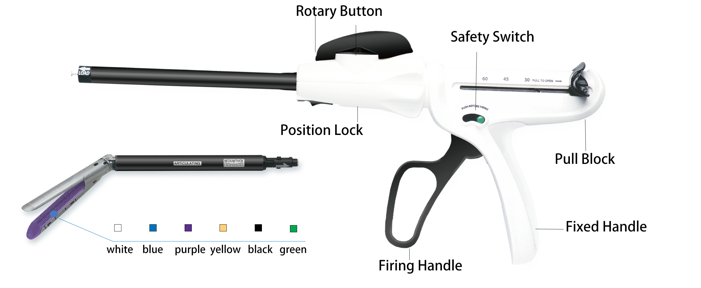Endoscopic linear cutter staplers and their loading units are essential tools in minimally invasive surgeries, particularly in gastrointestinal and thoracic procedures. These devices enable surgeons to cut and staple tissues internally, often with greater precision and less tissue trauma compared to traditional open surgeries.


Main Features:
Versatility: They come in various sizes and configurations to accommodate different tissue types and surgical needs.
Precision: Endoscopic linear cutter staplers offer precise cutting and stapling, allowing for consistent and reliable tissue closure.
Ease of Use: These devices are designed to be user-friendly, with ergonomic handles and intuitive controls for efficient operation.
Safety: Many models incorporate safety features such as tissue thickness sensors and mechanisms to prevent firing when not properly positioned.
Compatibility: They are compatible with various endoscopic systems, including laparoscopic and robotic platforms, enhancing their usability across different surgical setups.
Reliability: High-quality materials and manufacturing processes ensure the reliability and durability of these devices during surgical procedures.
Main Benefits:
Minimally Invasive: Endoscopic linear cutter staplers enable minimally invasive surgeries, reducing trauma, pain, and recovery time for patients compared to open surgeries.
Faster Procedures: By combining cutting and stapling into one step, these devices streamline surgical procedures, potentially reducing overall surgical time.
Reduced Complications: Precise tissue closure with staplers can minimize complications such as bleeding, leakage, and wound infections, promoting better postoperative outcomes.
Enhanced Patient Safety: Disposable loading units help maintain sterility and reduce the risk of cross-contamination between patients, contributing to improved patient safety.
Improved Surgeon Ergonomics: Ergonomically designed devices and loading units can reduce surgeon fatigue during prolonged procedures, enhancing surgical performance and reducing the risk of errors.
Loosening outside-Better blood-supply
Dynamic inside-Less bleedingheal faster
Innovative structure of cartridges
Three different heights of staple design

Type | Cutting and Suturing length | Application | Height of pins(mm) |
H--CCS30-W | 30mm | Thin tissue | 2.5/2.5/2.5 |
H--CCS30-B | 30mm | Normal thickness tissue | 3.5/3.5/3.5 |
H--CCS45-W | 45mm | Thin tissue | 2.5/2.5/2.5 |
H--CCS60-W | 60mm | Thin tissue | 2.5/2.5/2.5 |
H--CCS45-B | 45mm | Normal thickness tissue | 3.5/3.5/3.5 |
H--CCS45-G | 45mm | Thick tissue | 4.8/4.8/4.8 |
H--CCS60-B | 60mm | Normal thickness tissue | 3.5/3.5/3.5 |
H--CCS60-G | 60mm | Thick tissue | 4.8/4.8/4.8 |
Type | Cutting and Suturing length | Application | Height of pins(mm) |
H--CCR30-W | 30mm | Thin tissue | 2.5/2.5/2.5 |
H--CCR30-B | 30mm | Normal thickness tissue | 3.5/3.5/3.5 |
H--CCR45-W | 45mm | Thin tissue | 2.5/2.5/2.5 |
H--CCR60-W | 60mm | Thin tissue | 2.5/2.5/2.5 |
H--CCR45-B | 45mm | Normal thickness tissue | 3.5/3.5/3.5 |
H--CCR45-G | 45mm | Thick tissue | 4.8/4.8/4.8 |
H--CCR60-B | 60mm | Normal thickness tissue | 3.5/3.5/3.5 |
H--CCR60-G | 60mm | Thick tissue | 4.8/4.8/4.8 |
Type | Cutting and Suturing length | Application | Height of pins(mm) |
H--CCR30-T | 30mm | Normal Thin tissue | 2.0/2.5/3.0 |
H-CCR30-P | 30mm | Thick tissue | 3.0/3.5/4.0 |
H-CCR45-T | 45mm | Normal Thin tissue | 2.0/2.5/3.0 |
H-CCR60-T | 60mm | Normal Thin tissue | 2.0/2.5/3.0 |
H-CCR45-P | 45mm | Thick tissue | 3.0/3.5/4.0 |
H-CCR60-P | 60mm | Thick tissue | 3.0/3.5/4.0 |
H-CCR45-N | 45mm | Extra thick tissue | 4.0/4.5/5.0 |
H-CCR60-N | 60mm | Extra thick tissue | 4.0/4.5/5.0 |
